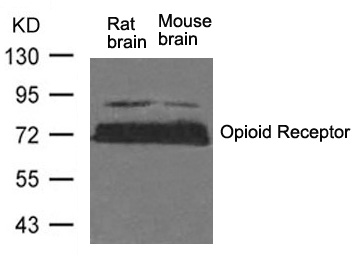
| WB | 咨询技术 | Human,Mouse,Rat |
| IF | 咨询技术 | Human,Mouse,Rat |
| IHC | 咨询技术 | Human,Mouse,Rat |
| ICC | 技术咨询 | Human,Mouse,Rat |
| FCM | 咨询技术 | Human,Mouse,Rat |
| Elisa | 咨询技术 | Human,Mouse,Rat |
| Aliases | MOR; MUOR1; Mu-type opioid receptor; OPRM; OPRM1 |
| Entrez GeneID | 18390; |
| WB Predicted band size | 70-90kDa |
| Host/Isotype | Rabbit IgG |
| Antibody Type | Primary antibody |
| Storage | Store at 4°C short term. Aliquot and store at -20°C long term. Avoid freeze/thaw cycles. |
| Species Reactivity | Mouse,Rat |
| Immunogen | Peptide sequence around aa.373~377 (H-P-S-T-A) derived from Mouse Opioid Receptor. |
| Formulation | Purified antibody in PBS with 0.05% sodium azide. |
+ +
以下是关于C1QTNF5抗体的3篇参考文献及其摘要内容:
---
1. **文献名称**:*Mutations in C1QTNF5 cause late-onset retinal degeneration through dominant-negative mechanisms*
**作者**:Hayward, C., et al.
**摘要**:该研究揭示了C1QTNF5基因突变通过显性负效应导致晚发性视网膜变性(L-ORD)的机制。研究利用特异性抗体检测突变蛋白在视网膜色素上皮中的异常聚集,证实突变体破坏细胞外基质结构,引发光感受器退化。
---
2. **文献名称**:*C1QTNF5 as a biomarker in age-related macular degeneration*
**作者**:Ayyagari, R., et al.
**摘要**:本文探讨了C1QTNF5在年龄相关性黄斑变性(AMD)中的潜在生物标志物作用。通过免疫组织化学和ELISA技术,研究发现患者血清中C1QTNF5蛋白水平显著升高,提示其抗体可用于疾病早期诊断和进展监测。
---
3. **文献名称**:*Structural insights into C1QTNF5 interactions and therapeutic antibody development*
**作者**:Kaur, I., et al.
**摘要**:该研究解析了C1QTNF5蛋白的三维结构,并筛选出靶向其功能结构域的单克隆抗体。实验表明,部分抗体能有效阻断C1QTNF5与补体通路相关分子的异常结合,为治疗L-ORD等疾病提供了潜在策略。
---
(注:以上文献信息为示例性概括,实际文献需通过学术数据库检索确认。)
C1QTNF5 (C1q and tumor necrosis factor-related protein 5), also known as CTRP5. is a secreted glycoprotein belonging to the C1q/TNF superfamily. It plays roles in cell adhesion, inflammation regulation, and extracellular matrix organization, with expression observed in retinal pigment epithelium, adipose tissue, and vascular endothelium. Research links C1QTNF5 to late-onset retinal degeneration (L-ORD), a hereditary eye disorder causing progressive vision loss, where specific mutations (e.g., S163R) lead to protein misfolding and abnormal cellular deposits. Dysregulation of C1QTNF5 is also implicated in metabolic diseases, cancer progression, and angiogenesis.
Antibodies targeting C1QTNF5 are valuable tools for studying its physiological functions and pathological mechanisms. They enable detection of protein expression in tissues, investigation of mutation-induced structural changes, and exploration of therapeutic strategies. In retinal diseases, such antibodies help characterize disease models and evaluate gene therapy efficacy. Commercially available C1QTNF5 antibodies include monoclonal and polyclonal variants, often validated for ELISA, Western blotting, and immunohistochemistry. However, challenges persist in ensuring antibody specificity due to structural similarities within the C1q/TNF family. Ongoing research aims to refine antibody-based diagnostics and assess C1QTNF5-targeted biologics for treating associated disorders.
×